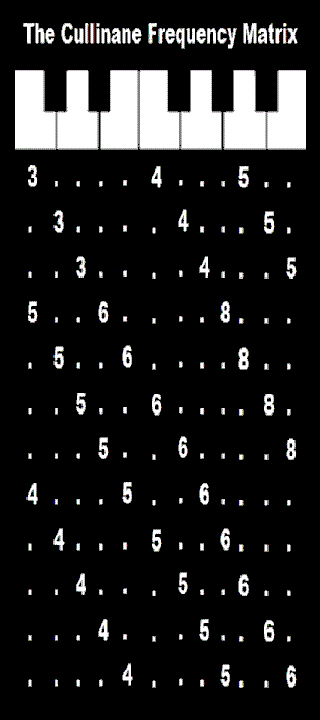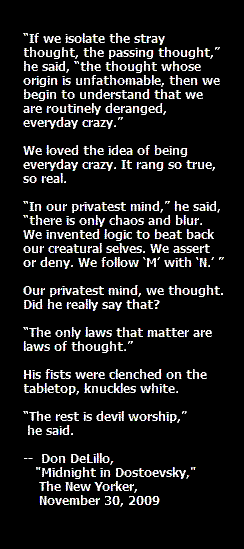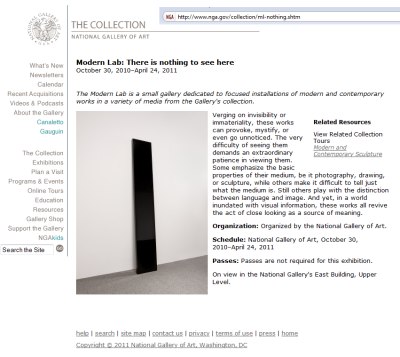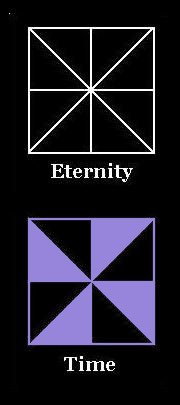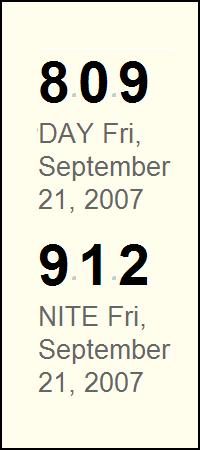Friday, February 4, 2022
A Monolith for Epstein
Saturday, August 23, 2014
Monolith
Wednesday, December 11, 2013
The Well-Tempered Monolith
Sunday, March 24, 2013
Monolith for Maggie…
Wednesday, March 7, 2012
Tuesday, April 12, 2011
The Monolith Epiphany
Continued from March 7, 2011
" One for my baby, and one more… "
![]()
See also this morning's previous posts "Unique Figure" and "One of a Kind."
Friday, September 13, 2024
Thursday, May 16, 2024
The Black Door Conspiracy
See "Black Door" posts. See also "Monolith."
Monday, January 8, 2024
The Star Brick
From a post of January 3, 2024 —
"Hello darkness, my old friend.
I’ve come to talk with you again."
The above image was flipped to reverse left and right.
Related reading: Other posts tagged Darkness and …
Related material: Other posts tagged Star Brick and . . .

"And we may see the meadow in December,
icy white and crystalline"
— Song lyric, "Midnight Sun"
Wednesday, January 3, 2024
Flippant
From the Log24 search in the previous post for "Dimensions" —
"Hello darkness, my old friend.
I’ve come to talk with you again."
The above image was flipped to reverse left and right.
Related reading: Other posts tagged Darkness and …
Monday, September 5, 2022
2001: A Time Odyssey
Friday, August 19, 2022
Tuesday, February 1, 2022
Wednesday, January 26, 2022
Wednesday, September 18, 2019
Unity
Monday, March 25, 2019
Clark’s Wake
Saturday, March 2, 2019
Monday, February 18, 2019
The Joy of Six

__________________________________________________________________________
See also the previous post.
I prefer the work of Josefine Lyche on the smallest perfect number/universe.
Context —
Lyche's Lynx760 installations and Vigeland's nearby Norwegian clusterfuck.
Friday, December 14, 2018
Sunday, March 19, 2017
Gravedigger’s Handbook
In memory of Jimmy Breslin, who reportedly died today at 88 —
From "Dimensions," (Log24, Feb. 15, 2015) —

"Hello darkness, my old friend.
I’ve come to talk with you again."
Thursday, September 8, 2016
Hope of Heaven, Oslo Style
The previous post deals with the theory, now becoming widely known,
that the musical "Grease" is really about Sandy's dying dream of heaven.
Another such dream in Oslo, described by the Vigeland Museum —
|
The Monolith "The Monolith was carved from one single granite block, hence the name (mono: one, litho: stone). Whereas the melancholy theme in the fountain is the eternal life cycle, the column gives room to a totally different interpretation: Man's longing and yearning for the spiritual and divine. Is the column to be understood as man's resurrection? The people are drawn towards heaven, not only characterised by sadness and controlled despair, but also delight and hope, next to a feeling of togetherness, carefully holding one another tight in this strange sense of salvation." |
I prefer a different monolith.
Saturday, March 5, 2016
Sunday, December 13, 2015
Another Opening, Another Show
Ben Brantley in tonight's online review of a show that
reportedly opened off-Broadway on Dec. 10, 2015 —
" 'Mattress' has its charms, but they do wear thin. "
See also The New York Times on Martin Gardner Nov. 30:
A companion image from this journal
on the "Mattress" opening date —

Midrash:
Vonnegut Asterisk
Thursday, December 10, 2015
Strange Myths
Peter Schjeldahl in the current (Dec. 14) New Yorker :
The phrase “outsider art” was coined in 1972 by a
British art historian, Roger Cardinal, to translate
the sense of “art brut ,” which Dubuffet had
considered rendering as art “raw,” “uncouth,” “crude,”
or “in the rough.” But the term misses the full thrust
of Dubuffet’s elevation of “people uncontaminated
by artistic culture,” as he called them. He aspired not
to make outsiders respectable but to destroy the
complacency of insiders. He disqualified even tribal
and folk artists, and spirited amateurs like Henri
Rousseau, for being captive to one tradition or another.
Art brut must be sui generis, from the hands and minds
of “unique, hypersensitive men, maniacs, visionaries,
builders of strange myths.”
The literary art of Fritz Leiber and Stephen King seems to
fit this definition.
Somewhat less brut — the literary art of Plato.
A non-literary illustration:

Time as "a moving
image of eternity.”
— Plato
Wednesday, December 9, 2015
Eternity (Not by Calvin Klein*)
The two symbols on the monolith

may, if one likes, be interpreted
as standing for Damnation Morning
and for the Windmill of Time.
* "Award-winning fashion icon."
— Harvard Graduate School of Design
Saturday, November 21, 2015
Saturday, October 10, 2015
The Mirror of Understanding
From The Snow Queen , by Hans Christian Andersen —
|
SEVENTH STORY. What Took Place in the Palace of the Snow Queen, and What Happened Afterward The walls of the palace were of driving snow, and the windows and doors of cutting winds. There were more than a hundred halls there, according as the snow was driven by the winds. The largest was many miles in extent; all were lighted up by the powerful Aurora Borealis, and all were so large, so empty, so icy cold, and so resplendent! Mirth never reigned there; there was never even a little bear-ball, with the storm for music, while the polar bears went on their hindlegs and showed off their steps. Never a little tea-party of white young lady foxes; vast, cold, and empty were the halls of the Snow Queen. The northern-lights shone with such precision that one could tell exactly when they were at their highest or lowest degree of brightness. In the middle of the empty, endless hall of snow, was a frozen lake; it was cracked in a thousand pieces, but each piece was so like the other, that it seemed the work of a cunning artificer. In the middle of this lake sat the Snow Queen when she was at home; and then she said she was sitting in the Mirror of Understanding, and that this was the only one and the best thing in the world. Little Kay was quite blue, yes nearly black with cold; but he did not observe it, for she had kissed away all feeling of cold from his body, and his heart was a lump of ice. He was dragging along some pointed flat pieces of ice, which he laid together in all possible ways, for he wanted to make something with them; just as we have little flat pieces of wood to make geometrical figures with, called the Chinese Puzzle. Kay made all sorts of figures, the most complicated, for it was an ice-puzzle for the understanding. In his eyes the figures were extraordinarily beautiful, and of the utmost importance; for the bit of glass which was in his eye caused this. He found whole figures which represented a written word; but he never could manage to represent just the word he wanted–that word was "eternity"; and the Snow Queen had said, "If you can discover that figure, you shall be your own master, and I will make you a present of the whole world and a pair of new skates." But he could not find it out. "I am going now to warm lands," said the Snow Queen. "I must have a look down into the black caldrons." It was the volcanoes Vesuvius and Etna that she meant. "I will just give them a coating of white, for that is as it ought to be; besides, it is good for the oranges and the grapes." And then away she flew, and Kay sat quite alone in the empty halls of ice that were miles long, and looked at the blocks of ice, and thought and thought till his skull was almost cracked. There he sat quite benumbed and motionless; one would have imagined he was frozen to death. …. |
Related material:
This journal on March 25, 2013:

Sunday, September 20, 2015
Orange Mass
"Blue Eyes took his Sunday painting seriously."
In memory of Jackie Collins, a post on Sinatra's favorite color.
Thursday, August 20, 2015
Figure

— "The Noble Rider and the Sound of Words"
For some backstory, click or touch the dark passage above.
See also Monolith (August 23, 2014).
Friday, July 3, 2015
High White Noon
Tuesday, April 28, 2015
Sunday, February 15, 2015
Dimensions
Thursday, December 11, 2014
Notes towards an Unreliable Narrator
Related material from this journal (Sept. 6, 2013) —

"Oblivion is not to be hired: The greater part must be
content to be as though they had not been, to be found
in the Register of God, not in the record of man."
— Sir Thomas Browne
See also the post Monolith of August 23, 2014, as well as
the history of Farkas Hall at Harvard and posts with that tag.
Saturday, November 1, 2014
Tuesday, April 8, 2014
The Gioconda Smile
From Log24 on Feb. 26, 2008 —
|
“Many dreams have been The Return of the Author, On Sartre’s Les Mots – “Writing helps him find his own place within this vast comedy. He does not take to writing seriously yet, but he is eager to write books in order to escape the comedy he has been compelled to take part in.” |
Monday, March 25, 2013
Art Wars:
Monolith for Maggie, continued from yesterday
"The young woman counted—
'Otu, abua, ato, ano, ise, isii, asaa'—
using what remained to her of
the secret language…."
— Opening sentence of the prologue to The Choir Boats,
a 2009 novel by Daniel A. Rabuzzi
The piano link in today's previous post suggests a review
of a post from Feb. 11, 2008. That post suggests in turn
a passage from the Trevanian classic The Eiger Sanction
that says, in part…
"Often it was unnecessary to finish a sentence…."
Saturday, December 31, 2011
The Uploading
"Design is how it works." — Steve Jobs
From a commercial test-prep firm in New York City—
From the date of the above uploading—
|
|
From a New Year's Day, 2012, weblog post in New Zealand—

From Arthur C. Clarke, an early version of his 2001 monolith—
"So they left a sentinel, one of millions they have scattered
throughout the Universe, watching over all worlds with the
promise of life. It was a beacon that down the ages has been
patiently signaling the fact that no one had discovered it.
Perhaps you understand now why that crystal pyramid was set…."
The numerical (not crystal) pyramid above is related to a sort of
mathematical block design known as a Steiner system.
For its relationship to the graphic block design shown above,
see the webpages Block Designs and The Diamond Theorem
as well as The Galois Tesseract and R. T. Curtis's classic paper
"A New Combinatorial Approach to M24," which contains the following
version of the above numerical pyramid—
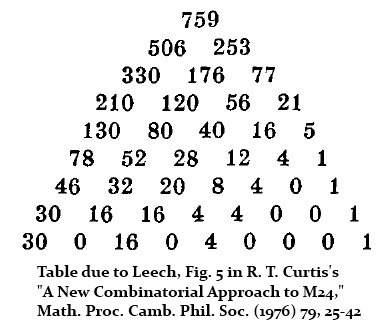
For graphic block designs, I prefer the blocks (and the parents)
of Grand Rapids to those of New York City.
For the barbed tail of Clarke's "Angel" story, see the New Zealand post
of New Year's Day mentioned above.
Saturday, December 3, 2011
Unified Theories
From David Weinberger's book
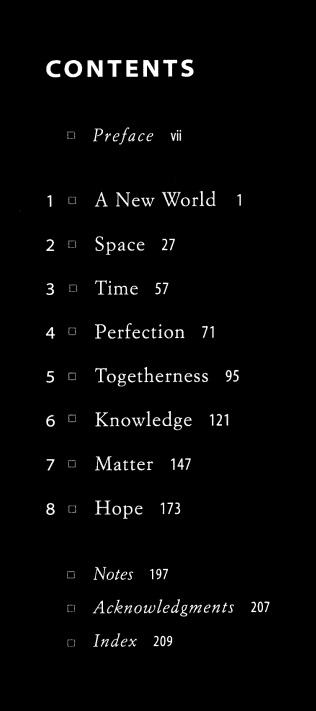
As Weinbergers go, I prefer Eliot.

Then there is my own theory of "small pieces loosely joined."
Sunday, April 10, 2011
Bedeviled
From tonight's online New York Times —
John McCracken, Sculptor of Geometric Forms, Dies at 76
McCracken died in Manhattan on Friday, April 8.
From Christopher Knight in tonight's online LA Times —
… the works embody perceptual and philosophical conundrums. The colored planks stand on the floor like sculptures….
McCracken was bedeviled by Stanley Kubrick's famously obscure science-fiction epic, "2001: A Space Odyssey," with its iconic image of an ancient monolith floating in outer space. The 1968 blockbuster was released two years after the artist made his first plank.
"At the time, some people thought I had designed the monolith or that it had been derived from my work," he told art critic Frances Colpitt of the coincidence in a 1998 interview.
Two photos of McCracken's 1967 Black Plank seem relevant—
November 28, 2010 (Click to enlarge) —
December 28, 2010 (Click to enlarge) —
Material that an artist might view as related, if only synchronistically—
Two posts in this journal on the dates the photos were taken—
The Embedding on November 28 and Dry Bones on December 28.
The photos are of an exhibition titled "There is nothing to see here" at the
National Gallery of Art, October 30, 2010-April 24, 2011 —
For related nihilism from the National Gallery, see "Pictures of Nothing" in this journal.
Some less nihilistic illustrations—

A photo by one of the artists whose work is displayed above beside McCracken's—

"Accentuate the Positive."
— Clint Eastwood
Monday, March 7, 2011
Point Taken
Recommended— An essay (part 1 of 5 parts) in today's New York TImes—
|
I don’t want to die in |
"I agree with one of the earlier commenters that this is a piece of fine literary work. And in response to some of those who have wondered 'WHAT IS THE POINT?!' of this essay, I would like to say: Must literature always answer that question for us (and as quickly and efficiently as possible)?"
For an excellent survey of the essay's historical context, see The Stanford Encyclopedia of Philosophy article
"The Incommensurability of Scientific Theories,"
First published Wed., Feb. 25, 2009,
by Eric Oberheim and Paul Hoyningen-Huene.
Related material from this journal—
Paradigms, Paradigms Lost, and a search for "mere geometry." This last includes remarks contrasting Euclid's definition of a point ("that which has no parts") with a later notion useful in finite geometry.
See also (in the spirit of The Abacus Conundrum )…

(Note the Borges epigraph above.)
Sunday, July 11, 2010
Philosophers’ Keystone
(Background— Yesterday's Quarter to Three,
A Manifold Showing, Class of 64, and Child's Play.)


Hermeneutics
Fans of Gregory Chaitin and Harry Potter
may consult Writings for Yom Kippur
for the meaning of yesterday's evening 673.
(See also Lowry and Cabbala.)
Fans of Elizabeth Taylor, Ava Gardner,
and the Dark Lady may consult Prime Suspect
for the meaning of yesterday's midday 17.
For some more serious background, see Dante—
"….mirando il punto 
a cui tutti li tempi son presenti "
– Dante, Paradiso, XVII, 17-18
“The symbol ![]() is used throughout the entire book
is used throughout the entire book
in place of such phrases as ‘Q.E.D.’ or
‘This completes the proof of the theorem’
to signal the end of a proof.”
— Measure Theory, by Paul R. Halmos, Van Nostrand, 1950


Halmos died on the date of Yom Kippur —
October 2, 2006.
Thursday, December 17, 2009
Roll Over, He Said
Part I–
Ironic Symbols
From St. Andrew’s Day, 2009:
Also on that date:
Supreme Court rejects Ford’s
appeal in rollover case
The New York Times this morning:
Roll over to learn more
Part II–
Also from
St. Andrew’s Day, 2009:
Monday, November 30, 2009
Tuesday, November 3, 2009
Levi-Strauss Died…
… on Friday, October 30, 2009 ………
(known to some as “Devil’s Night”)………
according to The New York Times …
…
A search in this journal for “Levi-Strauss” yields various entries, the most recent being “Autistic Enchantment” (Sept. 3, 2009).
Related material:
Today’s New York Times on autism
(A Powerful Identity, a Vanishing Diagnosis)
and Log24 on enchantment.
An instance of the latter (from Feb. 15, 2008):
Door
Step:
“Many dreams have been
brought to your doorstep.
They just lie there
and they die there.”
— Lyricist Ray Evans,
who died at 92
one year ago today
Associated Press –
Feb. 15, 2008
Today in History –
Thought for Today:
disenchantment with truth.”

Postscript of Nov. 3, 2009:
For more confusion, see
the works of Claude Levi-Strauss.
 But according to The Telegraph, Levi-Strauss
But according to The Telegraph, Levi-Strauss
died on Saturday, Oct. 31, All Hallows’ Eve.
According to Le Monde, he may have died
even later, on Sunday, Nov. 1, All Saints’ Day.
Tuesday, October 13, 2009
Tuesday October 13, 2009
This morning’s New York Times reports the deaths of Nuremberg interrogator Richard W. Sonnenfeldt and of avant-garde novelist and Beckett scholar Raymond Federman.
Symbols from this journal on the dates of their deaths:

For connotations of the symbol appropriate to the name Sonnenfeldt, see the link to A Sunrise for Sunrise in the entry of Saturday, Oct. 10.

— James Joyce, Finnegans Wake
Tuesday, October 6, 2009
Friday, July 3, 2009
Friday July 3, 2009
continued
“The tigers of wrath are wiser
than the horses of instruction.”
— Blake
“… the moment is not
properly an atom of time
but an atom of eternity.
It is the first reflection
of eternity in time, its first
attempt, as it were, at
stopping time….”
— Kierkegaard
|
Symmetry Axes
of the Square: 
From the cover of the
|
A Monolith
for Kierkegaard: |
Todo lo sé por el lucero puro
que brilla en la diadema de la Muerte.
— Rubén Darío
Related material:
The deaths of
Ernest Hemingway
on the morning of
Sunday, July 2, 1961,
and of Alexis Arguello
on the morning of
Wednesday, July 1, 2009.
See also philosophy professor
Clancy Martin in the
London Review of Books
(issue dated July 9, 2009)
on AA members as losers—
“the ‘last men,’ the nihilists,
the hopeless ones.”
Tuesday, April 7, 2009
Tuesday April 7, 2009
|
Bright Star and Dark Lady “Mexico is a solar country — but it is also a black country, a dark country. This duality of Mexico has preoccupied me since I was a child.” — Octavio Paz, |
||
|
Bright Star
|
Amen.
|
Dark Lady
|
The same story on
May 11, 2005
with a different
dark lady:

Sunday, March 8, 2009
Sunday March 8, 2009
Transit Authority
In memory of
Stanley Kubrick
(overlooked in
yesterday's memorial)
| "For believers the day of death, and even more the day of martyrdom, is not the end of all; rather, it is the 'transit' towards immortal life. It is the day of definitive birth, in Latin, dies natalis." |

"'Wherever you come near
the human race, there's layers
and layers of nonsense,'
says the Stage Manager in
Thornton Wilder's 'Our Town.'"
— Today's sermon
from Frank Rich



For more layers, see
James A. Michener's
The Source.
Sunday, February 15, 2009
Sunday February 15, 2009
| From April 28, 2008:
Religious Art
The black monolith of One artistic shortcoming The following One approach to "Transformations play See 4/28/08 for examples |
Related material:
| From Wallace Stevens: A World of Transforming Shapes, by Alan D. Perlis, Bucknell University Press, 1976, pp. 117-118:
"… his point of origin is external nature, the fount to which we come seeking inspiration for our fictions. We come, many of Stevens's poems suggest, as initiates, ritualistically celebrating the place through which we will travel to achieve fictive shape. Stevens's 'real' is a bountiful place, continually giving forth life, continually changing. It is fertile enough to meet any imagination, as florid and as multifaceted as the tropical flora about which the poet often writes. It therefore naturally lends itself to rituals of spring rebirth, summer fruition, and fall harvest. But in Stevens's fictive world, these rituals are symbols: they acknowledge the real and thereby enable the initiate to pass beyond it into the realms of his fictions. Two counter rituals help to explain the function of celebration as Stevens envisions it. The first occurs in 'The Pediment of Appearance,' a slight narrative poem in Transport to Summer. A group of young men enter some woods 'Hunting for the great ornament, The pediment of appearance.' Though moving through the natural world, the young men seek the artificial, or pure form, believing that in discovering this pediment, this distillation of the real, they will also discover the 'savage transparence,' the rude source of human life. In Stevens's world, such a search is futile, since it is only through observing nature that one reaches beyond it to pure form. As if to demonstrate the degree to which the young men's search is misaligned, Stevens says of them that 'they go crying/The world is myself, life is myself,' believing that what surrounds them is immaterial. Such a proclamation is a cardinal violation of Stevens's principles of the imagination. For in 'Notes Toward a Supreme Fiction' he tells us that ... the first idea was not to shape the clouds In imitation. The clouds preceded us. There was a muddy centre before we breathed. There was a myth before the myth began, Venerable and articulate and complete. From this the poem springs: that we live in a place That is not our own and, much more, not ourselves And hard it is in spite of blazoned days. We are the mimics. (Collected Poems, 383-84) Believing that they are the life and not the mimics thereof, the world and not its fiction-forming imitators, these young men cannot find the savage transparence for which they are looking. In its place they find the pediment, a scowling rock that, far from being life's source, is symbol of the human delusion that there exists a 'form alone,' apart from 'chains of circumstance.' A far more productive ritual occurs in 'Sunday Morning.'…." |
For transformations of a more
specifically religious nature,
see the remarks on
Richard Strauss,
"Death and Transfiguration,"
(Tod und Verklärung, Opus 24)
in Mathematics and Metaphor
on July 31, 2008, and the entries
of August 3, 2008, related to the
death of Alexander Solzhenitsyn.
Monday, September 8, 2008
Monday September 8, 2008

Related material:
Tuesday, July 31, 2007Aesthetics for JesuitsJoke The Guardian, July 26, “… inspired satire, laced with Jewish and Christian polemics, sparkling wit and dazzlingly simple effects. For Golgotha a stagehand brings on three crosses. ‘Just two,’ says Jay. ‘The boy is bringing his own.’ Tabori often claimed that the joke was the most perfect literary form.” |
Update at noon,
Sept. 9, 2008:
Tabori, a Jew from Hungary
and former screenwriter
(“No Exit“), died at 93
on July 23, 2007.
For related material on
another Jew from Hungary
click on the black monolith
(also known as
the Halmos tombstone).
Monday, May 26, 2008
Monday May 26, 2008
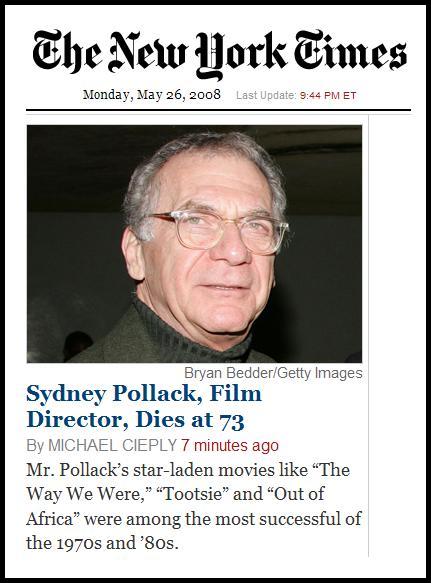
Great Directors
“After his return to acting in ‘Tootsie,’ Pollack took movie roles under directors Robert Altman in ‘The Player’ (1992), Woody Allen in ‘Husbands and Wives’ (1992) and Stanley Kubrick in ‘Eyes Wide Shut’ (1999). He said he chose roles in part to study other great directors.”
Monday, April 28, 2008
Monday April 28, 2008
The black monolith of
Kubrick's 2001 is, in
its way, an example
of religious art.

One artistic shortcoming
(or strength– it is, after
all, monolithic) of
that artifact is its
resistance to being
analyzed as a whole
consisting of parts, as
in a Joycean epiphany.
The following
figure does
allow such
an epiphany.

One approach to
the epiphany:
"Transformations play
a major role in
modern mathematics."
– A biography of
Felix Christian Klein
The above 2×4 array
(2 columns, 4 rows)
furnishes an example of
a transformation acting
on the parts of
an organized whole:

For other transformations
acting on the eight parts,
hence on the 35 partitions, see
"Geometry of the 4×4 Square,"
as well as Peter J. Cameron's
"The Klein Quadric
and Triality" (pdf),
and (for added context)
"The Klein Correspondence,
Penrose Space-Time, and
a Finite Model."
For a related structure–
not rectangle but cube–
see Epiphany 2008.
Tuesday, February 26, 2008
Tuesday February 26, 2008

Some thoughts from
the preceding Friday,
the birthday of actor
Kevin “You’re Next“
McCarthy:
|
“Writing helps him find his own place within this vast comedy. He does not take to writing seriously yet, but he is eager to write books in order to escape the comedy he has been compelled to take part in.”
|
The obituary of Burghardt
and The Four Last Things.
“Hell is other people.”
— Jean-Paul Sartre,
No Exit
With a laugh track.
Friday, February 22, 2008
Friday February 22, 2008
the idea of identity:
what it is to give
something a name
on Monday
and have it respond
to that name
on Friday….”
— Bernard Holland in
The New York Times
Monday, May 20, 1996
In 1564,
artist Michelangelo
died in Rome.

Idea: A Concept
in Art Theory
… Todo lo sé por el lucero puro
que brilla en la diadema de la Muerte
— Rubén Darío
Related material:
Yesterday’s entry
and Anthony Lane
in this week’s
New Yorker:
Friday, February 15, 2008
Friday February 15, 2008
“Many dreams have been
brought to your doorstep.
They just lie there
and they die there.”
— Lyricist Ray Evans,
who died at 92
one year ago today
Associated Press –
Today in History –
Thought for Today:
disenchantment with truth.”
–Jean-Paul Sartre
The Return of the Author, by Eugen Simion:
On Sartre’s Les Mots —
The craft of writing appeared to me as an adult activity, so ponderously serious, so trifling, and, at bottom, so lacking in interest that I didn’t doubt for a moment that it was in store for me. I said to myself both ‘that’s all it is’ and ‘I am gifted.’ Like all dreamers, I confused disenchantment with truth.”
This is given in The Oxford Dictionary of Quotations (1999) as
Like all dreamers, I mistook disenchantment for truth.
Also from the AP’s
Today in History —
Today’s Birthdays:
Actor Kevin McCarthy is 94.
Hopkins at Heaven’s Gate
(In context: October 2007)–

“Dolly’s Little Diner–
Home from Home”
Wednesday, February 13, 2008
Wednesday February 13, 2008
“Plot Would Thicken, if the
Writers Remembered It“
Gala Premiere:
FOUR FOR
HEAVEN’S GATE

full of numbers!”
“This movie is….
the most scandalous
cinematic waste I have
ever seen, and remember,
I’ve seen Paint Your Wagon.”
Monday, February 11, 2008
Monday February 11, 2008
“A shape of some kind
for something that
has no shape.”
— Roy Scheider
in “2010”
For further details,
click on the monolith.
See also the Keystone State’s
lottery numbers for Sunday–
Grammy night and the
date of Scheider’s death:

These numbers suggest
the following links.
For further details related
to death and religion, see
a version of the cheer
“1234, who are we for?”
For further details related
to Grammy night, see
6/17, 2007:
A selection from the
Stephen King Hymnal
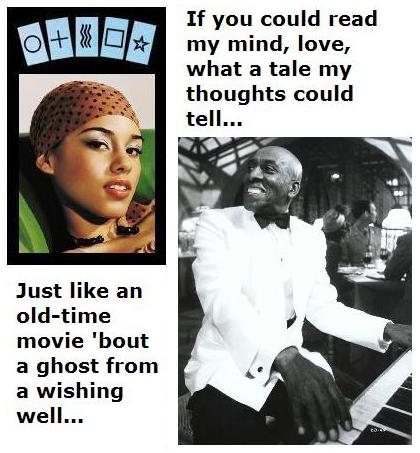
“… it’s going to be
accomplished in steps,
this establishment
of the Talented in
the scheme of things.”
— Anne McCaffrey,
Radcliffe ’47,
To Ride Pegasus
Thursday, November 29, 2007
Thursday November 29, 2007
|
From today's online NY Times:
Obituaries in the News
By THE ASSOCIATED PRESS
Published: [Wednesday] Gennie DeWeese BOZEMAN, Mont. (AP) — Gennie DeWeese, an artist known for her landscape paintings and woodblock prints whose works are displayed at museums across the Northwest, died Monday [November 26, 2007]. She was 86. DeWeese died at her studio south of Bozeman. Dahl Funeral Chapel confirmed her death. Her first oil painting was of her dog, done when she was 12 years old. In 1995, DeWeese received an honorary doctorate of fine arts from Montana State University, and she received the Montana Governor's Award for the Arts. |
Robert M. Pirsig in
Zen and the Art of Motorcycle Maintenance
(April 1974) —
|
"The rhetoricians of ancient Greece were the first teachers in the history of the Western world. Plato vilified them in all his works to grind an axe of his own and since what we know about them is almost entirely from Plato they’re unique in that they’ve stood condemned throughout history without ever having their side of the story told. The Church of Reason that I talked about was founded on their graves. It’s supported today by their graves. And when you dig deep into its foundations you come across ghosts." I look at my watch. It’s after two. "It’s a long story," I say. "You should write all this down," Gennie says. |
Quod erat
demonstrandum.
For more information,
click on the black monolith.
Related material:
Saturday, September 22, 2007
Saturday September 22, 2007
Friday, July 6, 2007
Friday July 6, 2007
of Good and Evil
continued from
Midsummer Night…
— Glenna Whitley, “Voodoo Justice,”
The New York Times, March 20, 1994

In Other Game News:
“Coxeter Exhuming Geometry”
suggests the following
illustration, based
in part on
Plato’s poem to Aster:

Related material:
and
The proportions of
the above rectangle
may suggest to some
a coffin; they are
meant to suggest
a monolith.
Saturday, May 12, 2007
Saturday May 12, 2007
Last night's entry "A Midrash for Hollywood" discussed a possible interpretation of yesterday's Pennsylvania Lottery numbers– mid-day 384, evening 952.
In memory of a blacklisted Hollywood screenwriter who died yesterday, here is another interpretation of those numbers.
First, though, it seems appropriate to quote again the anonymous source from "Heaven, Hell, and Hollywood" on screenwriters– "You can be replaced by some Ping Pong balls and a dictionary." An example was given illustrating this saying. Here is another example:
Yesterday's PA lottery numbers in the dictionary–
Webster's New World Dictionary,
College Edition, 1960–
Page 384: "Defender of the Faith"
Related Log24 entries:
"To Announce a Faith," Halloween 2006,
and earlier Log24 entries from
that year's Halloween season
Page 952: "monolith"
Related Log24 entries:
"Shema, Israel," and "Punch Line"
(with the four entries that preceded it).
It may not be entirely irrelevant that a headline in last night's entry– "Lonesome No More!"– was linked to a discussion of Kurt Vonnegut's Slapstick, that a film version of that novel starred Jerry Lewis, and that yesterday afternoon's entry quoted a vision of "an Ingmar Bergman script as directed by Jerry Lewis."
April is Math Awareness Month.
This year's theme is "mathematics and art."

"Art isn't easy."
— Stephen Sondheim
Tuesday, October 10, 2006
Tuesday October 10, 2006
Two Seconds

From Oct. 13 last year
(Yom Kippur):
|
A Poem for Pinter
Oct. 13, 2005 The Guardian on Harold Pinter, winner of this year's Nobel Prize for Literature: "Earlier this year, he announced his decision to retire from playwriting in favour of poetry," Michael Muskal in today's Los Angeles Times: "Pinter, 75, is known for his sparse and thin style as well as his etched characters whose crystal patter cuts through the mood like diamond drill bits." Robert Stone, A Flag for Sunrise (See Jan. 25): "'That old Jew gave me this here.' Egan looked at the diamond…. 'It's worth a whole lot of money– you can tell that just by looking– but it means something, I think. It's got a meaning, like.'
'Let's see,' Egan said, 'what would it mean?' He took hold of Pablo's hand cupping the stone and held his own hand under it. '"The jewel is in the lotus," perhaps that's what it means. The eternal in the temporal….'"
"Modal logic was originally developed to investigate logic under the modes of necessary and possible truth. The words 'necessary' and 'possible' are called modal connectives, or modalities. A modality is a word that when applied to a statement indicates when, where, how, or under what circumstances the statement may be true. In terms of notation, it is common to use a box [] for the modality 'necessary' and a diamond <> for the modality 'possible.'"
Commentary:
"Waka" also means Japanese poem or Maori canoe. (For instance, this Japanese poem and this Maori canoe.)
For a meditation on "bang splat," see Sept. 25-29. For the meaning of "tick tick," see Emily Dickinson on "degreeless noon." "Hash," of course, signifies "checkmate." (See previous three entries.) |
For language more suited to
the year's most holy day, see
this year's Yom Kippur entry,
from October 2.
That was also the day of the
Amish school killings in
Pennsylvania and the day that
mathematician Paul Halmos died.
For more on the former, see
Death in Two Seconds.
For more on the latter, see
The Halmos Tombstone.
Wednesday, October 4, 2006
Wednesday October 4, 2006
on Yom Kippur, 2006
“Prof. Paul Halmos died of pneumonia early in the morning of October 2, 2006. He was 90 years old. He is survived by his wife, Virginia Halmos. An obituary may be found at the website of the Mathematical Association of America….”
— Halmos’s home page
at Santa Clara University
For a memorial of sorts, see
Lovely, Dark and Deep.

Update of 8 PM Oct. 4 —
From Google Book Search:

This is the source of the
“Halmos tombstone” symbol,
which has been described in a
different form at Wikipedia:
“The tombstone, or halmos–
symbol ∎ (Unicode U+220E)–
is used in mathematics to denote
the end of a proof.”
This Unicode character is rendered
as an empty square in Explorer
and as a black square in Firefox.
Related material:
Thursday, February 16, 2006
Thursday February 16, 2006
Rabbi Yehuda Chitrik, storyteller
From James A. Michener‘s The Source:
“Trouble started in a quarter that neither Uriel nor Zadok could have foreseen. For many generations the wiser men of Zadok’s clan had worshipped El-Shaddai with the understanding that whereas Canaanites and Egyptians could see their gods directly, El-Shaddai was invisible and inhabited no specific place. Unequivocally the Hebrew patriarchs had preached this concept and the sager men of the clans accepted it, but to the average Hebrew who was not a philosopher the theory of a god who lived nowhere, who did not even exist in corporeal form, was not easy to comprehend. Such people were willing to agree with Zadok that their god did not live on this mountain– the one directly ahead– but they suspected that he did live on some mountain nearby, and when they said this they pictured an elderly man with a white beard who lived in a proper tent and whom they might one day see and touch. If questioned, they would have said that they expected El-Shaddai to look much like their father Zadok, but with a longer beard, a stronger voice, and more penetrating eyes.
Now, as these simpler-minded Hebrews settled down outside the walls of Makor, they began to see Canaanite processions leave the main gate and climb the mountain to the north, seeking the high place where Baal lived, and they witnessed the joy which men experienced when visiting their god, and the Hebrews began in subtle ways and easy steps to evolve the idea that Baal, who obviously lived in a mountain, and El-Shaddai, who was reported to do so, must have much in common. Furtively at first, and then openly, they began to climb the footpath to the place of Baal, where they found a monolith rising from the highest point of rock. Here was a tangible thing they could comprehend, and after much searching along the face of the mountain, a group of Hebrew men found a straight rock of size equal to the one accorded Baal, and with much effort they dragged it one starless night to the mountain top, where they installed it not far from the home of Baal….”
Valentine’s Day, 2006,
having had a heart attack
on Feb. 8, 2006–


The above monolith is perhaps more
closely related to El-Shaddai than to
Madonna, Grammy Night, and Baal.
It reflects my own interests
(Mathematics and Narrative)
and those of Martin Buber
(Jews on Fiction):

|
Monday, June 27, 2005
Monday June 27, 2005
Into the Dark
O dark dark dark. They all go into the dark,
The vacant interstellar spaces, the vacant into the vacant
….
And we all go with them, into the silent funeral,
Nobody’s funeral, for there is no one to bury.
I said to my soul, be still, and let the dark come upon you
Which shall be the darkness of God. As, in a theatre,
The lights are extinguished, for the scene to be changed
With a hollow rumble of wings, with a movement of
darkness on darkness….
— T. S. Eliot, Four Quartets
“I’m well past eighty now and fairly certain I won’t see ninety but I’d like more of a choice than Hell or Paradise when I leave. Now that we know the Bible was created by a vote of Emperor Constantine’s clergy, wouldn’t we all be better off if other options were offered? Or is the fear of what happens after death the glue that holds Religion together? I hope not because I believe better of God.
As a Deist, I have no fear or doubts of the way that life ends. I can bravely face the reality of ceasing to exist because the God of my heart comforts me by promising to provide a dark, starless night of nothingness when my visit is over.”
— Paul Winchell (pdf) (See previous entry.)
Paul Winchell was born at the winter solstice — the longest night — December 21, 1922.
For another view of the longest night, see the five Log24 entries ending on the day after the longest night of 2003. Summary of those entries:
After the Long Night
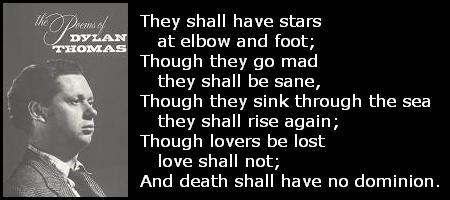
Saturday, June 25, 2005
Saturday June 25, 2005
Religious Symbolism
at Midnight:
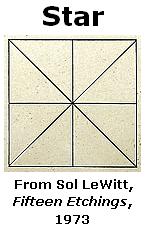
Related material:
Star Wars 6/13/05,
Dark City 6/14/05,
and De Arco, as well
as the following from
July 26, 2003:
|
Bright Star and Dark Lady "Mexico is a solar country — but it is also a black country, a dark country. This duality of Mexico has preoccupied me since I was a child."
— Octavio Paz, |
||
|
Bright Star
|
Amen.
|
Dark Lady
|
Tuesday, May 24, 2005
Tuesday May 24, 2005
Two Poles
From today’s New York Times:

From erraticimpact.com on Paul Ricoeur:
the narratologist Algirdas-Julien Greimas.
between the philosophical and religious
domains, attempting to reconcile
the two poles in his thought.”
| From today’s NYT obituary of Sol Stetin:
“Mr. Stetin, who emigrated from Poland at the age of 10 and dropped out of high school in the ninth grade, was fond of saying he got his education in the labor movement.” |
 |
continued:
“… it is not in isolation that the rhetorical power of such oppositions resides, but in their articulation in relation to other oppositions. In Aristotle’s Physics the four elements of earth, air, fire and water were said to be opposed in pairs. For more than two thousand years oppositional patterns based on these four elements were widely accepted as the fundamental structure underlying surface reality….
 The structuralist semiotician Algirdas Greimas introduced the semiotic square (which he adapted from the ‘logical square’ of scholastic philosophy) as a means of analysing paired concepts more fully….”
The structuralist semiotician Algirdas Greimas introduced the semiotic square (which he adapted from the ‘logical square’ of scholastic philosophy) as a means of analysing paired concepts more fully….”
— Daniel Chandler, Semiotics for Beginners
Poetry’s Bones and
Theme and Variations.
Other readings on polarity:
Log24, May 24, 2003, and
from July 26, 2003:
|
Bright Star and Dark Lady “Mexico is a solar country — but it is also a black country, a dark country. This duality of Mexico has preoccupied me since I was a child.” — Octavio Paz, |
||
|
Bright Star
|
Amen. |
Dark Lady
|
Tuesday, April 5, 2005
Wednesday, March 31, 2004
Wednesday March 31, 2004
To Be
A Jesuit cites Quine:
"To be is to be the value of a variable."
— Willard Van Orman Quine, cited by Joseph T. Clark, S. J., in Conventional Logic and Modern Logic: A Prelude to Transition, Woodstock, MD: Woodstock College Press, 1952, to which Quine contributed a preface.
Quine died in 2000 on Xmas Day.
From a July 26, 2003, entry,
The Transcendent Signified,
on an essay by mathematician
Michael Harris:
|
Kubrick's |
Harris's |
From a December 10, 2003, entry:
Putting Descartes Before Dehors


"Descartes déclare que c'est en moi, non hors de moi, en moi, non dans le monde, que je pourrais voir si quelque chose existe hors de moi."
For further details, see ART WARS.
The above material may be regarded as commemorating the March 31 birth of René Descartes and death of H. S. M. Coxeter.
For further details, see
Wednesday, March 17, 2004
Wednesday March 17, 2004
William H. Pickering,
Dec. 24, 1910 – March 15, 2004
|
At |
Thursday, January 8, 2004
Thursday January 8, 2004
Natasha’s Dance
| “… at the still point, there the dance is….”
“… to apprehend — T. S. Eliot, Four Quartets |
It seems, according to Eliot’s criterion, that the late author John Gregory Dunne may be a saint.
Pursuing further information on the modular group, a topic on which I did a web page Dec. 30, 2003, the date of Dunne’s death, I came across a review of Apostol’s work on that subject (i.e., the modular group, not Dunne’s death, although there is a connection). The review:
“A clean, elegant,
absolutely lovely text…”
Searching further at Amazon for a newer edition of the Apostol text, I entered the search phrase “Apostol modular functions” and got a list that included the following as number four:
Natasha’s Dance:
A Cultural History of Russia,
which, by coincidence, includes all three words of the search.
For a connection — purely subjective and coincidental, of course — with Dunne’s death, see The Dark Lady (Jan. 1, 2004), which concerns another Natasha… the actress Natalie Wood, the subject of an essay (“Star!“) by Dunne in the current issue of the New York Review of Books.
The Review’s archives offer another essay, on science and religion, that includes the following relevant questions:
“Have the gates of death
been opened unto thee?
Or hast thou seen the doors
of the shadow of death?”
From my December 31 entry:
In memory of
John Gregory Dunne,
who died on
Dec. 30, 2003:
For further details, click
on the black monolith.
Wednesday, December 31, 2003
Wednesday December 31, 2003
In memory of
John Gregory Dunne,
who died on
Dec. 30, 2003:
For further details, click
on the black monolith.
See, too, last year's entries
for Dec. 30 and 31:
"… he might add under his breath,
like the professor in The Last Battle
who has passed on to the next life,
'It's all in Plato, all in Plato:
bless me, what do they teach them
at these schools!' "
Sunday, October 26, 2003
Sunday October 26, 2003
ART WARS for
Trotsky’s Birthday
Part I:
Symbols
From my entry of July 26, 2003, in memory
of Marathon Man director John Schlesinger:
|
Bright Star and Dark Lady “Mexico is a solar country — but it is also a black country, a dark country. This duality of Mexico has preoccupied me since I was a child.” — Octavio Paz, |
||
|
Bright Star
|
Amen. |
Dark Lady
|
For the meaning of the above symbols, see
Kubrick’s 1x4x9 monolith in 2001,
the Halmos tombstone in Measure Theory,
and the Fritz Leiber Changewar stories.
Part II:
Sunday in the Park with Death
To Leon from Diego —
Details of a mural,
A Dream of a Sunday Afternoon
in Alameda Park,
Fresco, 1947-48,
Alameda Hotel, Mexico City:
Three’s a Crowd:
Symbol:
Monday, September 8, 2003
Monday September 8, 2003
ART WARS Sept. 1, 2003:
Sir Terry Frost Dies
A noted English abstract painter died at 87 on Monday, September 1. From a memorial essay on Sir Terry Frost, born in 1915, in The Daily Telegraph:
“He was educated at Leamington Spa Central School where he edited the art magazine, but left at 15 to work….” His first jobs included, the Telegraph says, painting “the red, white and blue targets on to fighter planes.”

The “target” the Telegraph refers to
is known as the Royal Air Force Roundel.
It may indeed have functioned as a target, but it was originally intended only as a distinctive identifying mark.
Some of Frost’s later work may be viewed at the British Government Art Collection. For some of Frost’s work more closely related to his early “target” theme, see the Badcock’s Gallery site.
An example:

For related religious
and cinematic material, see
Pilate, Truth, and Friday the Thirteenth,
a meditation for Good Friday of 2001,
a meditation for Friday the Thirteenth
of September, 2002,
and
from the day Frost died, which concludes
with links related to the religious symbol of
2001:

Thursday, September 4, 2003
Thursday September 4, 2003
Monolith
“Music can name the unnameable
and communicate the unknowable.”
— Quotation attributed to Leonard Bernstein
“Finally we get to Kubrick’s ultimate trick…. His secret is in plain sight…. The film is the monolith. In a secret that seems to never have been seen by anyone: the monolith in the film has the same exact dimensions as the movie screen on which 2001 was projected.”
— Alchemical Kubrick 2001, by Jay Weidner
My entry of Saturday, August 30,
included the following illustration:

My entry of Monday, September 1,
concluded with the black monolith.

“There is little doubt that the black monolith
in 2001 is the Philosopher’s Stone.”
— Alchemical Kubrick 2001, by Jay Weidner
The philosopher Donald Davidson
died on Saturday, August 30.
The New York Times says that as an undergraduate, Davidson “persuaded Harvard to let him put on ‘The Birds’ by Aristophanes and played the lead, Peisthetairos, which meant memorizing 700 lines of Greek. His friend and classmate Leonard Bernstein, with whom he played four-handed piano, wrote an original score for the production.”
Perhaps they are still making music together.
Monday, September 1, 2003
Monday September 1, 2003
The Unity of Mathematics,
or “Shema, Israel”
A conference to honor the 90th birthday (Sept. 2) of Israel Gelfand is currently underway in Cambridge, Massachusetts.
The following note from 2001 gives one view of the conference’s title topic, “The Unity of Mathematics.”
Reciprocity in 2001by Steven H. Cullinane
|
Related Reading
For four different proofs of Euler’s result, see the inexpensive paperback classic by Konrad Knopp, Theory and Application of Infinite Series (Dover Publications).
Related Websites
Evaluating Zeta(2), by Robin Chapman (PDF article) Fourteen proofs!
Zeta Functions for Undergraduates
Reciprocity Laws
Reciprocity Laws II
Recent Progress on the Langlands Conjectures
For more on
the theme of unity,
see

Saturday, July 26, 2003
Saturday July 26, 2003
The Transcendent
Signified
“God is both the transcendent signifier
and transcendent signified.”
— Caryn Broitman,
Deconstruction and the Bible
“Central to deconstructive theory is the notion that there is no ‘transcendent signified,’ or ‘logos,’ that ultimately grounds ‘meaning’ in language….”
— Henry P. Mills,
The Significance of Language,
Footnote 2
“It is said that the students of medieval Paris came to blows in the streets over the question of universals. The stakes are high, for at issue is our whole conception of our ability to describe the world truly or falsely, and the objectivity of any opinions we frame to ourselves. It is arguable that this is always the deepest, most profound problem of philosophy. It structures Plato’s (realist) reaction to the sophists (nominalists). What is often called ‘postmodernism’ is really just nominalism, colourfully presented as the doctrine that there is nothing except texts. It is the variety of nominalism represented in many modern humanities, paralysing appeals to reason and truth.”
— Simon Blackburn, Think,
Oxford University Press, 1999, page 268
The question of universals is still being debated in Paris. See my July 25 entry,
That entry discusses an essay on
mathematics and postmodern thought
by Michael Harris,
professor of mathematics
at l’Université Paris 7 – Denis Diderot.
A different essay by Harris has a discussion that gets to the heart of this matter: whether pi exists as a platonic idea apart from any human definitions. Harris notes that “one might recall that the theorem that pi is transcendental can be stated as follows: the homomorphism
Harris illustrates this with
an X in a rectangle:

For the complete passage, click here.
If we rotate the Harris X by 90 degrees, we get a representation of the Christian Logos that seems closely related to the God-symbol of Arthur C. Clarke and Stanley Kubrick in 2001: A Space Odyssey. On the left below, we have a (1x)4×9 black monolith, representing God, and on the right below, we have the Harris slab, with X representing (as in “Xmas,” or the Chi-rho page of the Book of Kells) Christ… who is, in theological terms, also “the variable par excellence.”
|
Kubrick’s |
Harris’s |
For a more serious discussion of deconstruction and Christian theology, see
Saturday July 26, 2003
Funeral March
|
John Schlesinger dead at 77; LOS ANGELES – Oscar-winning director John Schlesinger, who daringly brought gay characters into mainstream cinema with Midnight Cowboy and tapped into nightmares with the teeth-drilling torture of Marathon Man, died Friday at 77. The British-born filmmaker…. died about 5:30 a.m…. |
Schlesinger also directed The Day of the Locust, based on a novel by Nathanael West.
See Heaven, Hell, and Hollywood and
From the latter:
“Then you know your body’s sent,
Don’t care if you don’t pay rent,
Sky is high and so am I,
If you’re a viper — a vi-paah.”
— The Day of the Locust,
by Nathanael West (1939),
New Directions paperback,
1969, page 162
This song may be downloaded at
That same site begins with a traditional Mexican song…
“La cucaracha, la cucaracha,
ya no puede caminar,
porque no quiere,
porque le falta
marihuana que fumar.”
(“The cockroach, the cockroach,
can’t walk anymore,
because he doesn’t want to,
because he has no
marihuana to smoke.”)
This suggests an appropriate funeral march for John Schlesinger:
“Ya murió la cucaracha, ya la llevan a enterrar…” – La Cucaracha
Those attending Schlesinger’s wake, as opposed to his funeral, may wish to perform other numbers from the Pot Culture page, which offers a variety of “viper” songs.
|
Bright Star and Dark Lady “Mexico is a solar country — but it is also a black country, a dark country. This duality of Mexico has preoccupied me since I was a child.” — Octavio Paz, |
||
|
Bright Star
|
Amen.
|
Dark Lady
|
For the meaning of the above symbols, see
Kubrick’s 1x4x9 monolith in 2001,
the Halmos tombstone in Measure Theory,
and the Fritz Leiber Changewar stories.
Concluding Unscientific Postscript:
Oh, yes… the question of
Heaven or Hell for John Schlesinger…
Recall that he also directed the delightful
Cold Comfort Farm and see
last year’s entry for this date.
Saturday, April 19, 2003
Saturday April 19, 2003
Harrowing
In memory of the many who have died on April 19, most notably Octavio Paz.
"There is a suggestion of Christ descending into the abyss for the harrowing of Hell. But it is the Consul whom we think of here, rather than of Christ."
— Introduction to Malcolm Lowry's classic novel Under the Volcano, by Stephen Spender
|
|
|
"Hey, big Spender, spend a little time
with me." — Song lyric
For a somewhat deeper meditation on time, see Architecture of Eternity.
See also Literature of the Descent into Hell.
"Mexico is a solar country — but it is also a black country, a dark country. This duality of Mexico has preoccupied me since I was a child."
— Octavio Paz, quoted by Homero Aridjis

Amen.
Concluding Unscientific Postscripts:
"Once upon a time…" — Anonymous
"It's quarter to three…" — Sinatra
Saturday, April 5, 2003
Saturday April 5, 2003
Art Wars:
Mathematics and the
Emperor's New Art
From Maureen Dowd's New York Times column of June 9, 2002:
"The shape of the government is not as important as the policy of the government. If he makes the policy aggressive and pre-emptive, the president can conduct the war on terror from the National Gallery of Art."
|
NY Times, April 5, 2003: |
|
Meanwhile, at the Washington Post, another example of great determination and strength of character:
Donald Coxeter Dies: Leader in Geometry
By Martin Weil
Washington Post Staff Writer
Saturday, April 5, 2003
"Donald Coxeter, 96, a mathematician who was one of the 20th century's foremost specialists in geometry and a man of great determination and strength of character as well, died March 31 at his home in Toronto."
From another Coxeter obituary:
In the Second World War, Coxeter was asked by the American government to work in Washington as a code-breaker. He accepted, but then backed out, partly because of his pacifist views and partly for aesthetic reasons: "The work didn't really appeal to me," he explained; "it was a different sort of mathematics."
For a differing account of how geometry is related to code-breaking, see the "Singer 7-cycle" link in yesterday's entry, "The Eight," of 3:33 PM. This leads to a site titled
An Introduction to the
Applications of Geometry in Cryptography.
"Now I have precisely the right instrument, at precisely the right moment of history, in exactly the right place."
— "Patton,"
the film

Added Sunday, April 6, 2003, 3:17 PM:
The New York Times Magazine of April 6
continues this Art Wars theme.

(Cover typography revised)
The military nature of our Art Wars theme appears in the Times's choice of words for its cover headline: "The Greatest Generation." (This headline appears in the paper, but not the Internet, version.)
Some remarks in today's Times Magazine article seem especially relevant to my journal entry for Michelangelo's birthday, March 6.
"…Conceptualism — suddenly art could be nothing more than an idea….
LeWitt moved between his syntax of geometric sculptures and mental propositions for images: concepts he wrote on paper that could be realized by him or someone else or not at all. Physical things are perishable. Ideas need not be."
— Michael Kimmelman, chief art critic of the New York Times, April 6, 2003
Compare this with a mathematician's aesthetics:
"A mathematician, like a painter or a poet, is a maker of patterns. If his patterns are more permanent than theirs, it is because they are made with ideas."
— G. H. Hardy, A Mathematician's Apology (1940), reprinted 1969, Cambridge U. Press, p. 84
It seems clear from these two quotations that the real conceptual art is mathematics and that Kimmelman is peddling the emperor's new clothes.
Friday, March 7, 2003
Friday March 7, 2003
Lovely, Dark and Deep

On this date in 1923, "Stopping by Woods on a Snowy Evening," by Robert Frost, was published. On this date in 1999, director Stanley Kubrick died. On this date in 1872, Piet Mondrian was born.
"….mirando il punto
a cui tutti li tempi son presenti"
— Dante, Paradiso, XVII, 17-18

Chez Mondrian
Kertész, Paris, 1926
 6:23 PM Friday, March 7:
6:23 PM Friday, March 7:
From Measure Theory, by Paul R. Halmos, Van Nostrand, 1950:
"The symbol ![]() is used throughout the entire book in place of such phrases as 'Q.E.D.' or 'This completes the proof of the theorem' to signal the end of a proof."
is used throughout the entire book in place of such phrases as 'Q.E.D.' or 'This completes the proof of the theorem' to signal the end of a proof."


